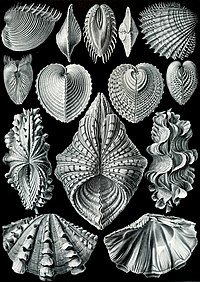
Photo from wikipedia
Abstract RNA/DNA ratio (RDR) has been reported to be a feasible biochemical indicator for measuring the growth of numerous aquatic animal species. Nevertheless, its applicability has not been investigated to… Click to show full abstract
Abstract RNA/DNA ratio (RDR) has been reported to be a feasible biochemical indicator for measuring the growth of numerous aquatic animal species. Nevertheless, its applicability has not been investigated to date in the pearl oyster Pinctada fucata (Gould, 1850). A laboratory experiment was undertaken to determine the relationship between RDR and growth rate in P. fucata postlarvae. The face-centered central composite design was used with three important factors (temperature, algal concentration and stocking density) simultaneously varied to produce a variety of growth rates. Temperature ranged between 18 and 34 °C, algal concentration between 5 and 100 cells μL―1, stocking density between 0.2 and 2.5 in.. mL―1. Postlarvae were fed with a 1: 1 mixture of Isochrysis zhanjiangensis and Pavlova viridis over the course of experiment. Results showed that RDR was affected significantly by the first- and second-order effects of and first-order interactions among three factors, but the interactions were negative to the growth of pearl oyster postlarvae. Within the ranges of three factors examined, algal concentration was most important, followed by temperature in influencing the growth of P. fucata postlarvae. RDR was highly positively correlated with specific growth rate (SGR) and absolute growth rate (AGR). Simple linear regression equations of shell height-based growth rates regarding RDR were established, SGR (% d―1) = ―0.05 + 2.01RDR (R2 = 0.98); AGR (μm d―1) = ―0.02 + 2.82RDR (R2 = 0.96). Lack-of-fit test indicated their high adequacy. The models have greater advantages over conventional means of assessing somatic growth, and can be utilized to reliably evaluate recent growth of P. fucata postlarvae under concurrent variations of three factors examined in the present study.
Journal Title: Aquaculture Reports
Year Published: 2021
Link to full text (if available)
Share on Social Media: Sign Up to like & get
recommendations!